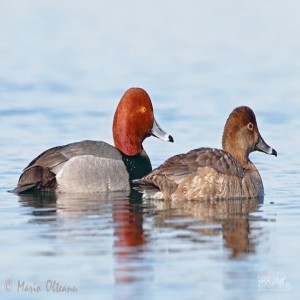 Redhead males are known for their gleaming cinnamon head setting off a body marked in black and business gray. The females and young Redheads are a uniform brown with the same black-tipped, blue-gray bill as the male. They are very sociable ducks and can be found in large flocks, especially in winter along the Gulf Coast. Because of the large range of habitation, it is considered by the IUCN as least concern.
Redhead males are known for their gleaming cinnamon head setting off a body marked in black and business gray. The females and young Redheads are a uniform brown with the same black-tipped, blue-gray bill as the male. They are very sociable ducks and can be found in large flocks, especially in winter along the Gulf Coast. Because of the large range of habitation, it is considered by the IUCN as least concern.
Location: Animals Formerly at Zoo
Share:
Range
Bahamas, Bermuda, Canada, Cayman Islands, Cuba, Guatemala, Haiti, Mexico, Turks and Caicos Islands,
United States
Habitat
Redheads breed mainly in the seasonal ponds and other wetlands of the Midwest’s prairie pothole region, reservoirs, sewage ponds, streams, and cropland ponds as well as marshes of the Great Basin and Canada. In the winter they gather on the Gulf of Mexico.
Conservation Status
Least Concern
Primary Threats
Gestation
Incubation period is 22 – 28 days
Litter
Clutch size of 7-8 eggs. Eggs are creamy white to pale, olive buff or sometimes pale, buffy brown.
2-2.6 inches in length and 1.5 -1.9 inches in width.
Behavior
Redheads fly faster than most ducks, with a rapid, shallow wingbeat and flight pattern that is more erratic than other ducks. During the mating time, unmated males form “courting parties” with mated pairs. They seek the female’s attention by drawing their head and neck back and erecting the crown and neck feathers in a “kink necked” display, giving a meow call. The mated birds, particularly the female, typically chase the bachelor males with head held low and bill open.
Reproduction
The female works alone in building a circular nest which when finished measures 9 inches to 2 feet across in low water or if high water atop muskrat houses. The nest rim of the finished nest reaches 7-10 inches above the water. Some females create an arching cover over the bowl by bending vegetation over it. Redheads pair up during the winter and the bond strengthens during spring migration. Redheads are seasonally monogamous. Females will lay some of their eggs in other birds’ nest to maximize having a clutch.
Wild Diet
Redheads eat submerged aquatic plants, including green algae, musk grass, hard stem bulrush, pondweed, and widgeon grass. Classified as diving ducks, they also dabble in shallow water by tipping tail-up to reach for submerged vegetation and invertebrates. They have also been known to eat fish eggs, snails, zebra mussels, caddisflies, midges, and mayflies
Zoo Diet

